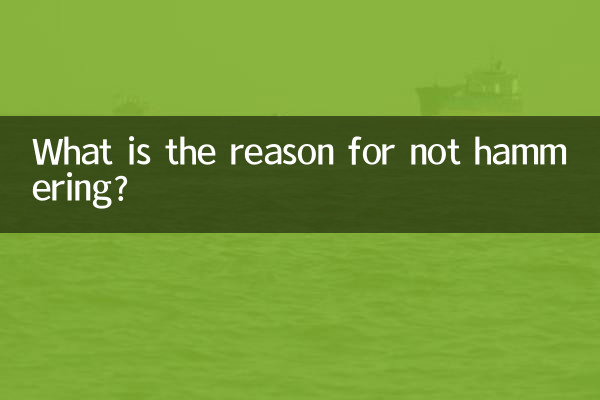Title: What is the reason for not hammering?
Recently, the "hammer or not hammer" phenomenon that has been hotly debated across the Internet has attracted widespread attention. This topic stems from the controversial discussions on certain events on social media, especially when celebrities, companies or social hot topics are involved. Netizens often use "hammer or not" to express doubts or verification of the truth. This article will combine the hot topics in the past 10 days, analyze the reasons for the "hammer or not hammer" phenomenon, and display relevant hot content through structured data.
1. The background of the phenomenon of “hammer but not hammer”

The term "hammer or no hammer" comes from the Internet slang, which means "whether there is solid evidence." In the era of information explosion, there are endless incidents that are difficult to distinguish between true and false. Netizens expressed their questioning of the authenticity of the incidents by "hammering or not hammering". The following are hot topics related to "hammer or not" in the past 10 days:
| Date | hot topics | focus of discussion | heat index |
|---|---|---|---|
| 2023-11-01 | Tax evasion incident involving a celebrity | Is it true | ★★★★★ |
| 2023-11-03 | Product quality issues of a company | The authenticity of user complaints | ★★★★ |
| 2023-11-05 | A reversal of a certain social event | The truth awaits investigation | ★★★ |
2. Analysis of the causes of the phenomenon of “hammer not hammering”
1.Insufficient information transparency: In many incidents, the truth is blurred due to the lack of timely response from the authorities or the parties concerned, and netizens can only pursue questions through "hammer or no hammer".
2.crisis of confidence: Some reversal events in the past have made the public doubt authoritative information and tend to seek verification on their own.
3.Communication characteristics of social media: Fragmented information can easily lead to speculation, and "hammer or not" has become a quick way to express one's attitude.
3. Analysis of typical cases
Take the "tax evasion incident of a certain celebrity" as an example. After the incident was exposed, netizens were divided into two groups: one group believed that there was "substantiation", while the other group questioned the authenticity of the evidence. The following is a comparison of the views of both sides:
| point of view | Supporting reasons | Objections |
|---|---|---|
| There is real hammer | The exposed financial records are clear | Records may have been tampered with |
| No real hammer | No official notification | Investigation takes time |
4. How to deal with the phenomenon of “hammer but not hammer”
1.Official response in a timely manner: Authoritative institutions or parties should clarify as soon as possible to avoid the spread of rumors.
2.Netizens seek rational verification: Avoid blindly following the trend and wait for more evidence.
3.objective media reporting: Avoid one-sided guidance and provide comprehensive information.
5. Forecast of future trends
As the public's demand for information authenticity increases, the phenomenon of "hammering but not hammering" may become the norm. The following are possible future directions:
| Trend | possibility | influence |
|---|---|---|
| More fact-checking mechanisms | high | Reduce disinformation |
| Increased netizen participation | in | Increased pressure from public opinion |
To sum up, the phenomenon of “hammering or not hammering” reflects the contradiction between the public’s desire for the truth and the information age. Only by increasing transparency and strengthening communication can unnecessary speculation be reduced and the rebuilding of social trust be promoted.

check the details

check the details